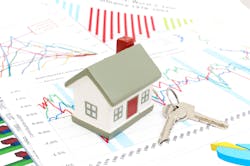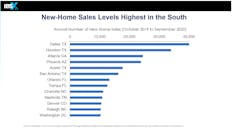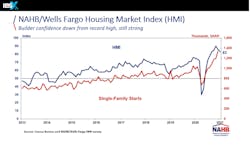IBS Session Coverage: 2021 Housing & Economic Outlook
Despite technical difficulties that paralyzed its virtual exhibit hall, education and events still proceeded (with some rescheduling). Perhaps the most anticipated general session was “The 2021 Housing & Economic Outlook,” a deep dive into the uncertain state of the nation’s economy and housing market, held on February 10th.
The presenters for the session were a trio of PhDs: Robert Dietz of the National Association of Home Builders, David Berson of Nationwide Mutual Insurance Co, Dublin, OH, and Frank Nothaft, CBE, CoreLogic, Vienna, VA.
Dietz welcomed attendees and quickly handed the session over to Berson who gave the first of three presentations, each addressing different facets of the overall economic picture.
Macroeconomic Outlook
In 2020, GDP growth declined at a 3.5 percent rate, mainly due to the COVID recession—the biggest drop since 1946 and the abrupt end of wartime production. However, strong growth in the second half of the year made it a much better number than it might have been.
For 2021, Berson and his group predict the growth rate to be near 5.5 percent, the fastest pace since 1984. The reason why:
· Vaccines — the leisure and hospitality industry has been rocked by the virus; more and more people being vaccinated will open these industries up once more
· Easy monetary policy — interest rates are at record lows and the Fed indicates no urge to raise them any time soon
· Fiscal stimulous — the Biden Administration looks determined to push ahead with a package somewhere in the neighborhood of $1.9 trillion, with or without Republican votes
Unemployment averaged 8.1 percent in 2020 and was nearing 15-20 percent at the bottom of the slump (very near Depression-levels). The US is currently back to 6.5 percent. For 2021 Berson is predicting an average unemployment rate of 5.5 percent, with strong hopes it may go lower and continue to decline.
The Federal Interest Rate is near zero, with no tightening anywhere on the horizon. The next raise might not be until 2025 or even later. Short term interest rates are effectively going to be zero for the next 3-4 years.
Long term interest rates—those tied to the 10-year Treasury Note—have moved up one percentage point since the start of the year. This is happening not because the Fed is tightening, but because the economy is picking back up. The Fed will be watching inflation closely (and so, therefore, should you). Inflation will have to move above 2 percent for a considerable period of time before the Fed decides to raise long term rates. For the end of 2021, Berson thinks the 10-year Treasury Note Yield will go up to about 1.5 percent (it is now at about 1.1 percent).
Mortgage rates are heavily influenced by the 10-year Note. The 30-year fixed rate mortgage (according to Freddy Mac) fell to under 2.7 percent—an all-time low. It has moved up a little this year. By the end of the year, Berson estimates the 30-year rate will sit somewhere just above 3 percent.
Notable—and a notable difference between where we find ourselves today and where we were back in the Great Recession—is that spread between mortgages and Treasury Notes is falling. This means that, based on the strength of the economy, lenders feel the chance of homeowners defaulting on loans is not that serious.
Due to changes in the way census data is being collected, it is difficult to get a reliable number on new household formation, but an informed estimate indicates some two million more households this year will be needing a place to live. In addition, the share of the population between 25 and 39—those first-time buyers through first-time move-up buyers—has moved up significantly.
The problem those buyers will be facing is that there are just not that many new homes for sale. In December just 300,000 new homes were on the market. And as for existing homes, Berson and his team have never seen fewer existing homes for sale: slightly over one million. This lack of availability is shifting buyers over to the new home side of the market.
Strong demand coupled with a low supply in the middle of a growing economy spells higher home prices. Prices are, in fact, up 10 percent over last year. And these gains look to be more sustainable than they were during the early 80s buying boom.
Housing Market
Beson then surrendered the microphone to Nothaft, who zeroed in on the housing market.
One year ago home sales were doing very well. In the six months prior to the pandemic new home sales were up 12 percent YoY. The pandemic crushed activity in the spring of 2020, but it bounced back through the summer and into the fall. For the full calendar year, 2020 turned out to be the best year for new home sales since 2007—above 2019 levels.
Demand is mainly in areas of population growth. Total growth over last year in the US was 1.15 million—but a more important factor is relocation. Sates with the largest population growth in 2020 were TX, FL, AZ and NC, and that is where the high demand for new construction will be. And this, by the way, is nothing new; for decades there has been a shift from the northeast to the south and southwest.
The CoreLogic Home Price Index through the month of December shows home prices up 9.2 percent in the national index. Demand is up, inventory is limited, and prices are rising. For 2021, robust appreciation rates should be seen in the first few months, with a gradual tapering off. For calendar year 2021, Nothaft and his team predict an average growth in home prices of 6.9 percent. (Local markets, of course, may do better or worse.)
Why the decline? Interest rates will climb (eventually, slightly), while inventory will rise towards the end of the year.
Price growth is good for building home equity wealth, and right now the Home Equity Wealth Rate in the US is highest it has ever been. The average amount of home equity wealth gain over the last year was about $5,300, largely due to home prices (and again, this varies according to region).
The US Average Home Equity per borrower is at $194,000, allowing homeowners the flexibility to borrow against their home’s value for remodeling or additions, both of which have been popular during the pandemic. There was a 3.7 percent rise in improvement spending in 2020.
Meanwhile, the rental market is seeing a shift from high density (high rise apartment buildings) to single-family rental homes, a dramatic shift driven by the pandemic. People don’t want to be downtown in a densely populated area close to the office. Instead, they want to be out in the suburbs working from home. But will this trend continue?
Growth Amidst Headwinds
Robert Dietz then ran the anchor leg of the session. He began with five key points:
· The virus crisis will continue, at least through the end of February
· 50 percent vaccination rate will probably be achieved by the end of April (possibly May); 75 percent rate should be achieved by the end of October
· There will be accelerating growth throughout 2021 (with corresponding increases in interest rates)
· Single-family construction and remodeling construction will see gains for 2021, but lower than in 2020
· Housing affordability risks erosion in 2021 due to climbing rates and rising costs
Dietz and the NAHB see a rise in GDP of 3.6 percent in 2021, with possibly and “upside surprise” due to pent up demand.
He pointed out that during the crisis, policymakers in Washington had done a relatively good job on both monetary and fiscal policy. Relative, that is, to such other developed Western economies such as France and the U.K. Their effort had managed to prevent what might have been a much more serious economic decline. In fact, the US economy has a good deal of momentum behind it as we move into the spring of 2021.
Again, rates will increase, but overall remain low for the next four years. But even a slight rise may cause a problem in affordability, particularly at the lower end of the market. There has been, in fact, a decline in affordability ever since the end of the Great Recession. Only about 58 percent of new and existing home sales are actually affordable for the typical US household. There is a good deal of risk entering the market for first-time home buyers.
The top issue on the construction side of the market is supply Lumber prices are on a roller-coaster ride. From mid-April 2020 to mid-September 2020 prices increased 170 percent. Mid-January saw a slide, but prices are once again up. Currently, the high price of lumber is adding $10,000 to $20,000 to the price of a newly-built home. The NAHB, in its role as an industry advocate, is trying to increase toe domestic supply of softwood lumber and work out lumber disputes with Canada.
There are also concerns about environmental, tax and labor policies under the new Biden administration. Rising regulatory burdens eventually get passed along to buyers in the form of higher prices.
And, as it does with so many of the skilled trades, the labor shortage continues. The market remains very tight. The residential construction market has been a bright spot in the current economy with 30,000 more workers now than a year ago.
The NAHB/Wells Fargo Housing Market Index hit an all-time high level of 90 in the fall of 2020. It has since declined to 83 in the last two months, which is still very strong. There should be more gains to come in single-family construction. The index is based on a survey of homebuilders, and two items stand out: 80 percent of builders see a higher demand for home offices; housing demand (in general) is moving to lower-cost, lower-density markets.
The NAHB forecast is typically a conservative one, and predicts growth, but slower growth rates than 2020. Permit data from the Building Geography Index shows big growth in the suburbs. Multifamily construction will stabilize headed into 2022. And there should be a 4 percent growth rate for the remodeling market in 2021.
The residential construction industry is now larger than it was a year ago, while the nonresidential market has shrunk, and will probably continue to shrink unless large infrastructure investments move forward.
“A real flip of the 2008 narrative,” Dietz said, and then opened the floor for questions.
About the Author
Steve Spaulding
Editor-in-Chief - CONTRACTOR
Steve Spaulding is Editor-in-Chief for CONTRACTOR Magazine. He has been with the magazine since 1996, and has contributed to Radiant Living, NATE Magazine, and other Endeavor Media properties.


